The world of fish is a varied and diverse place that offers many exciting discoveries. One such discovery is the snake-like fishes, which are often mistaken for real snakes due to their long slender bodies and undulating movements. These interesting creatures come in all shapes and sizes, from tiny minnows to giant eels.
While some of the hobbyists like to have a fish that looks like a snake; and the rests are afraid or want to avoid them.
Yeah, some of them could be dangerous for your pond or other inhabitants in there. But most of them are just fascinating and peaceful water creatures. There could be different reasons why people want to know about them.
However, from my personal interest, I round up 14 fishes that look like a snake (As I didn’t find any complete article regarding this topic, so I hope my effort will not be in vain).
Let’s take a look at the 14 most common fishes that look like snakes:
- Kuhli Loach
- Ophichthidae/Snake eel
- Snakehead
- Reedfish/Ropefish
- Bichir
- Mastacembelus erythrotaenia/Fire eel
- Pipefish
- Hagfish
- Zebra Moray
- Eelpouts
- Northern pike
- Lungfish
- Lamprey
- Violet goby/Dragon Fish
Here are some similar articles we’ve covered on our site. If you feel interested, click the links below to read them.
6 Fishes That are Similar to Lizards.
13 Fishes That have Eel-like Appearances.
12 Fishes with Dragon-like Appearances.
Now let’s discuss more about these fishes with snake like appearances.
14 Most Common Fishes That Look Like Snakes:
In this section, we’re going to talk about all those 14 fishes. Their appearances, food habits, origins, habitats, and many more.
1. Kuhli loach/ Coolie Loach:
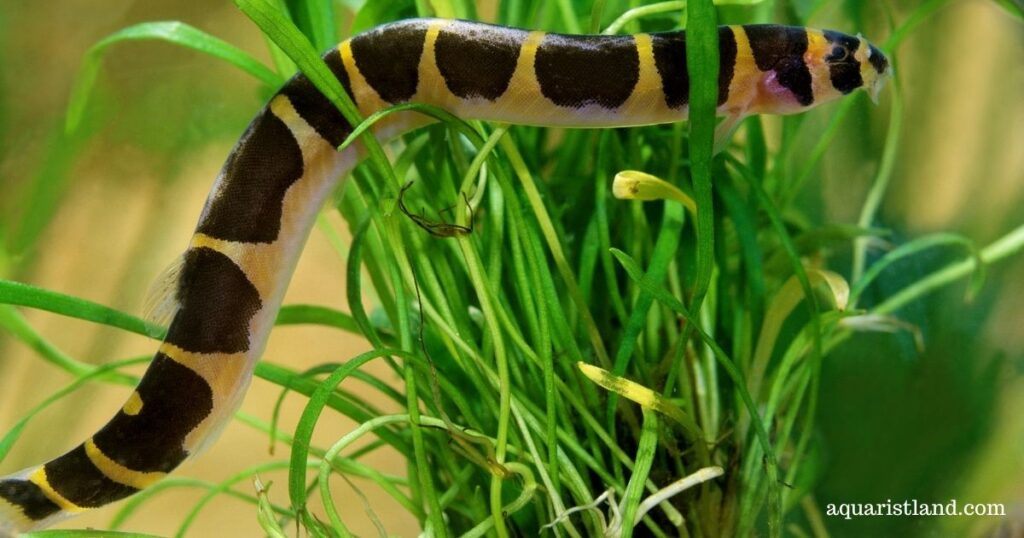
Kuhli Loach is one of the most common freshwater fish that looks like a snake you may encounter.
It’s a colorful, eel-shaped fish with four pairs of barbels around its mouth and tiny fins. Its dorsal fin starts behind the middle of its body, while an anal fin well beyond this point marks the end to its tail. The eyes are covered with transparent skin, distinguishing between males and females difficult when they’re not actively breeding.
However, their skin color and body shape will make you confused with a snake; Khuli Loach has 10-12 dark brown or black vertical bars lined up on top from head to backside marked by salmon-pink gaps in between them; along with light underbellies shining through! And when mating season arrives, their colors become more pronounced.
Male Khuli Loaches are more muscular and often larger than females. They also have pectoral fins that can be large, paddle-shaped, or even have some pigment in them. Males usually become much smaller when breeding; the female will sometimes grow to a size bigger than her male counterpart while their ovaries remain visible through the skin before spawning occurs.
The eggs they produce come out greenish, but only about 300 hatches successfully. Kuhli loaches reach maturity at 2 3/4 inches (7 cm) with a maximum length of 4 inches (10cm). This fish can live up to 14 years.
Khuli Loach/Coolie Loaches are very reclusive creatures who prefer to be in hiding during the day. Khuli loaches make excellent scavengers and can be found burrowing under tank ornaments if they do not have a sandy substrate underneath them, which is where they feel most comfortable.
They originate from Indonesia and the Malay Peninsula, but luckily, their snake-like bodies will allow you to house one anywhere!
2. Ophichthidae/Snake eel:
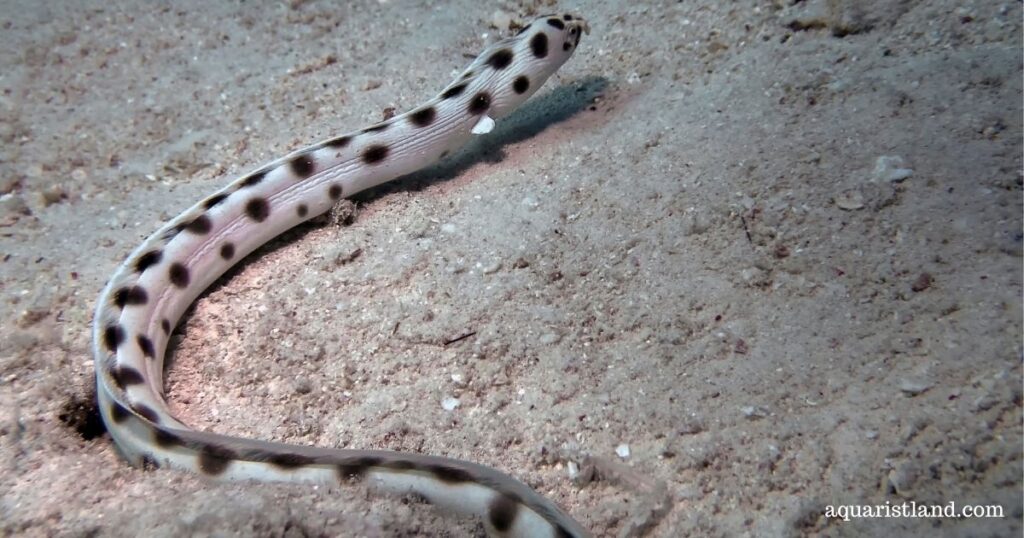
The Ophichthidae family is a group of fish that are known as snake eels and can be found in temperate to tropical waters around the world. This genus was given its name from Greek “Ophis” (serpent) and ichthys (“fish”) because they look like snakes, having long cylindrical bodies with scales on their skin.
They inhabit many different environments such as coastal shallows or even rivers which makes them an interesting species for those who study marine life.
The Ophichthidae is a family of marine fish that range in total length from 5 cm (2.0 in) to 2 meters or more, and they can be found both on the bottom of the ocean as well as floating out at sea level near our shores after being washed ashore by large storms.
They have camouflage patterns like other poisonous animals, such as snakes, so predators won’t catch them off guard with their bright colors while hiding deep underwater for safety reasons.
3. Snakehead:
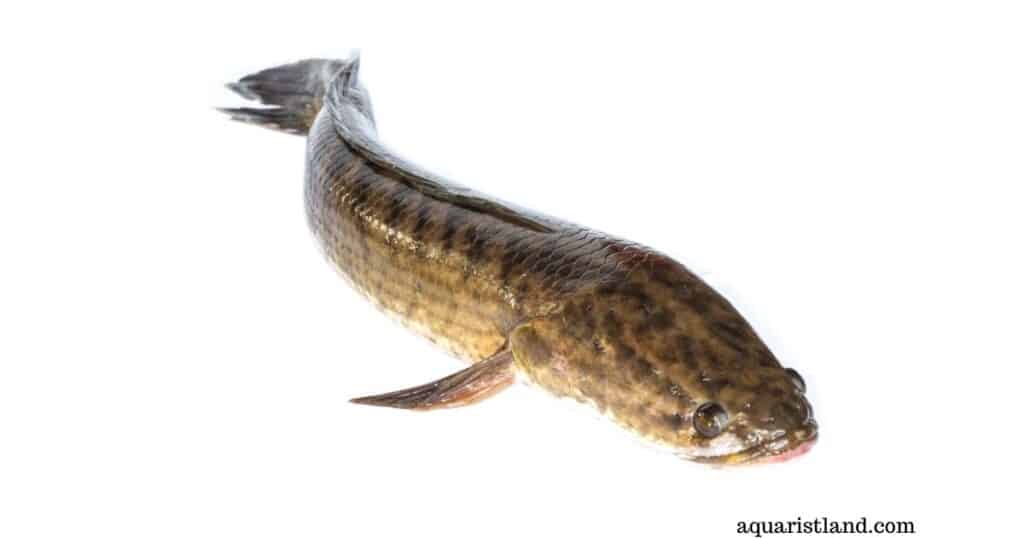
Snakeheads are freshwater fish of the family Channidae, order Channiformes. They can be recognized by their snake-like head shape and elongated body with long fins that resemble a snakeskin pattern.
These carnivore fish have teeth in both jaws, an enlarged mouth at the front end for sucking prey into its wide gape, and powerful muscles behind to compress it against hard surfaces so they can’t escape or avoid being swallowed whole!
Snakeheads are masters of disguise and can be found in lakes, creeks, ponds, or rivers all across North America. They live together with other fish such as the Northern Pike from time to time but will always make a meal out of them if they get too close! This fish has an elongated body that is cylindrical and fast-moving.
Snakeheads have various sizes, with some species not exceeding 10 inches in length while others can be up to 3 ft. long. Snakeheads are thrust-feeders that consume plankton, aquatic insects, and mollusks when small but mainly feed on other fish or frogs as adults.
Also, this snake looking fish you can have in your aquarium or pond.
4. Reedfish/Ropefish:

The Reedfish (Erpetoichthys calabaricus), also known as snakefish or ropefish, is from the family of bichir. It’s a beautiful creature that can survive in very oxygen-poor water. It possesses lungs rather than gills and has the ability to live on land or underwater for extended periods.
Reedfish has a long and slender body, reaching up to 15 inches in length. The species has an elongated body with no ventral fin, but it does have well-separated dorsal spines that support articulated rays and a membrane.
The more interesting aspect of the Reedfish is its lungs. Unlike most other fish who would suffocate without access to air or water containing enough dissolved oxygen content, this species can breathe outside their aquatic environment as they maintain lung function even after hatching from eggs!
The Erpetoichthys calabaricus comes from West Africa’s freshwater regions and lives both above ground (and out of the water) or below surface level, depending on the environment.
However, they prefer living near slower-moving waters because their bodies are not built well enough to swim against currents such as rivers. Currently, no known predators are hunting down this species. Still, humans have been found cutting away at their natural habitat – including setting up palm oil plantations which destroy slow-moving water areas where these creatures thrive – leading them closer towards extinction.
5. Bichir:
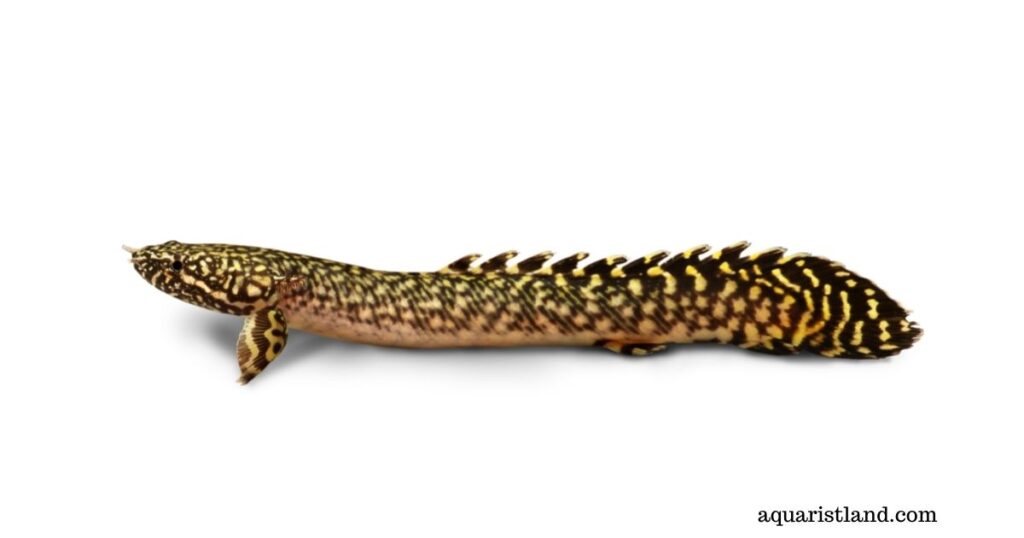
The bichirs and the Reedfish comprise the family of archaic-looking ray-finned fish, Polypteridae. They are the only families in order Polypteriformes. Found only in freshwater habitats in tropical Africa and Nile River system, mainly swampy floodplains or estuaries.
This tropical fish that looks like a snake is characterized by its unique dorsal finlets, which vary from seven to 18 instead of a single fin on the back like most other fishes.
Each individual dorsal finlet has bifid (double-edged) tips different from any other fins because they have sharp spines; all others only consist of soft rays.
The body is covered with thick bonelike scales called rhombic ganoid scales – these types of scales are more similar to tetrapods than teleost fishes but also serve as protection against predators such as humans who would want to eat them for food or sell their meat at marketplaces across the continent where Bichir thrives.
Bichirs have an excellent way of breathing. They are able to breathe air through slits on the top of their heads and use gill arches that look like leaves for oxygen intake in water. Their body length ranges from 25 cm (9 inches) to over 100 cm depending upon species variation and morphology
6. Mastacembelus erythrotaenia/Fire eel:
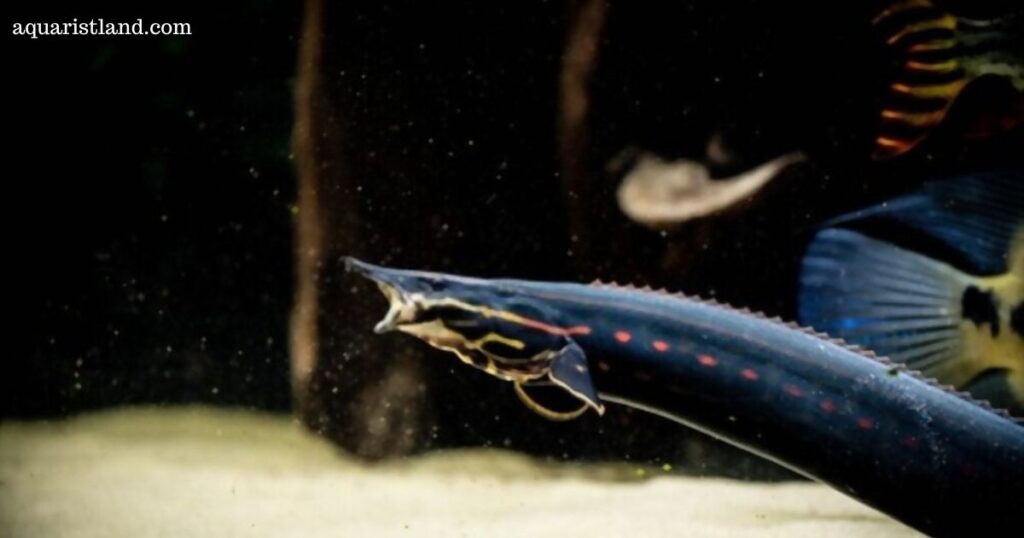
“Mastacembelus erythrotaenia,” also known as “Fire eel,” is another popular freshwater aquarium fish that look like snake.
The fire eel is a fantastic fish that comes in many colors, shapes, and sizes. They have spines on their body’s dorsal surface, which make them look like they’re wearing a suit of armor! The coloration varies from olive to bright yellow and can be stripped or blotched with black markings.
The fire eel is not a true eel but an extremely elongated fish with a distinctive pointed snout and underslung mouth. It’s part of the spiny group that includes tire track, peacock eels too!
The small dorsal spine precedes the dorsal fin in all these fishes because they are so predisposed to hide from predators by burying their bodies into sand or mud on ocean floors near coral reefs where you can find them.
Fluorescently colored stripes and spots line the body of this long eel. The base coloring is a deep brown/grey, but they are often marked with reds that vary in intensity depending on age and condition on their lighter belly.
Its markings stand out most vividly when it’s young: usually yellow or amber-colored before turning to a deep shade of crimson as its gets older – especially around fin edges like pectoral fins, dorsal fins, anal fins etcetera which have an edging for those colors
The fire eels’ brightly striped bodies make them one of the more visible species among these snakelike freshwater fish; they can reach up to 1 meter (3 ft) long at maximum.
“Mastacembelus erythrotaenia” are found throughout Southeast Asia and spread out as far southward as Sri Lanka because aquarium enthusiasts introduced it after its discovery near Bangkok around the 1970s (Gerald 1991).
It’s highly popular among hobbyists for this very reason: despite being omnivorous, these fishes will eat anything given to them, so you don’t need to worry about feeding time anymore!
7. Pipefish (Small fish that look like snake) :
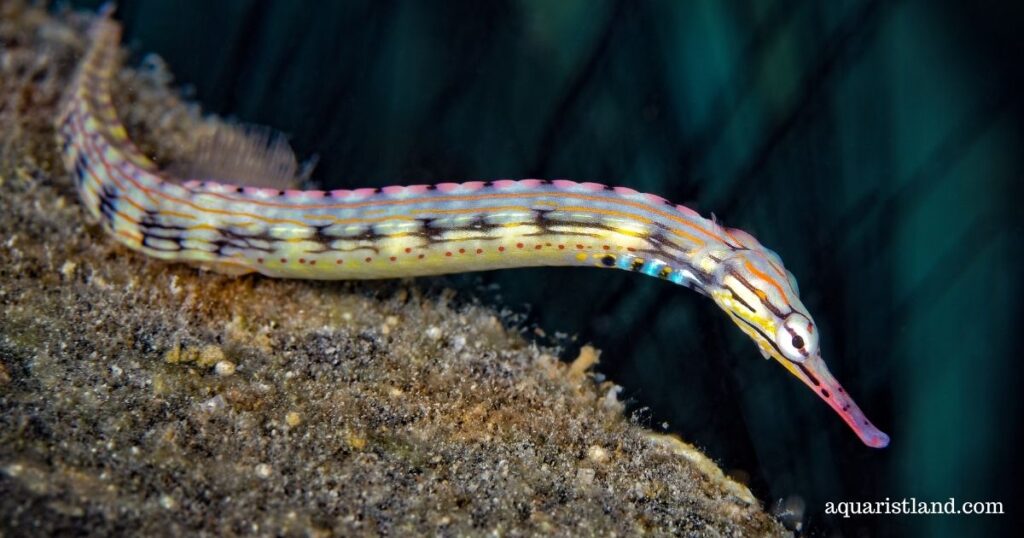
Pipefishes or pipe-fishes are a subfamily of small fishes that look like snakes, which, together with the seahorses and seadragons, form the family Syngnathidae.
The pipefish looks like a straight-bodied seahorse with tiny mouths. Ironically, the name is derived from its peculiar snout, which resembles a long tube ending in an upward-facing and toothless mouth opening.
The body is skinny and snake-like but lacks scales or fins; instead, it has armor plating that forms into ridges along with their bodies, so they appear angular rather than round when cut vertically through their center as most other fish do not have this defense mechanism.
The dorsal fins are always present and the principal (in some species, only) organ of locomotion. Ventral fins are absent; other fins may or may not be developed. Gill openings placed near the upper posterior angle on gill cover with extremely small gaps in between each opening for water to enter efficiently without resistance from air bubbles that would hinder movement through a larger hole.
Some pipefish have prehensile tails that are used similarly to a seahorse. However, the majority of species use their caudal fin for locomotion and diving into the sand in search of food or shelter. Some species’ fins are more developed than others are.
For example, flagtail pipefish swim comparatively fast with strong kicks from their tailfin. In contrast, other fish may be slow swimmers as they utilize only small movements by way of rapid dorsal movement.
The pipefish is a marine dweller, and most species are found in tropical or temperate zones. Pipefishes have been spotted near coasts, coral reefs, seagrass beds; they’re usually 35-40 cm long (about 14 to 15 inches), with some exceptions being freshwater types of this fish.
8. Hagfish:

Hagfish are eel-shaped, slime-producing marine fish that dates back to 300 million years ago. Hagfish have a skull but no vertebral column like most animals with such anatomy do, and their sister group is the jawed vertebrates, including humans. It’s a saltwater fish that looks like a snake.
This creature can produce an unusual amount of sticky goo-like substance when agitated or in distress. That helps them escape from predators as it can be difficult for some species (such as sharks) to eat something covered in slimy mucous strands. If they get tangled up by those strands to consume prey freely, others may find themselves unable to open their mouth without getting stuck on these slippery substances.
Hagfish are typically about 50 cm (19.7 in) long, with the largest known species being Eptatretus goliath at 127 cm (4 ft 2 in). Some have been seen as small as 4 cm (1.6 in), while other types of the-Myxine kuoi and Myxine pequenoi seem to reach no more than 18 cm or 7 inches if they’ve reached their maximum size!
Hagfish come in various lengths; some can be up to 37 centimeters which is just under 1 foot, but others may only grow up to 16 centimeters like those found off the coast of New Zealand.
Hagfish are squiggly, pinkish eel-like creatures with no scales. They have creepy eyespots and tooth-like structures that jut out from their mouths.
Hagfish live in the seabed or shallow water to feed on dead fish, often poking at its prey with long slimy tentacles before devouring it headfirst – sometimes swallowing them whole!
Another thing more disgusting about hagfish is how they reproduce. Male members release sperm bundles into a female’s cloaca if she happens to be pregnant (but not always), which then plugs up her breathing tube so that she’ll die; this guarantees fertilization and provides free food for hungry baby hagfishes come time for the birth!
The hagfish has no proper fins and a mouth with two pairs of horny teeth on the bottom. They use their tooth-like projections to pull off food instead of vertically articulating jaws as most vertebrates do. This is because they lack jaw structures altogether in place of horizontal moving ones with tooth-like projections used to draw prey closer towards their pharynx.
It’s a fish with a snake-like body, small fins, and slimy skin, making it the right choice for today’s blog topic.
9. Zebra moray:

The zebra moray is a medium-sized fish with an average length of 50 cm. However, it can grow up to 150cm long. It is one of the most beautiful and unique-looking fish out there. The body has a zebra pattern with dark brown to black colors, contrasted by white stripes on top, and has the common name “zebra.”
The short snout on this nocturnal creature helps them hunt their prey. They exclusively feed on crustaceans, sea urchins, or mollusks during nighttime hours when other animals would be sleeping!
The Zebra Moray Eel is one of the most common eels and a perfect choice for those who have an aquarium. It’s docile, spends much of its time hidden in caves but will come out to socialize if given enough space. These slow-moving creatures are relatively easy to care for, and they’re fun too!
The zebra moray is a benthic fish, which can be found in the Indo-Pacific area of eastern Africa and western Brazil. They live on rocky or coral reefs as well as shallow coastal water up to 40 meters deep.
10. Eelpouts:
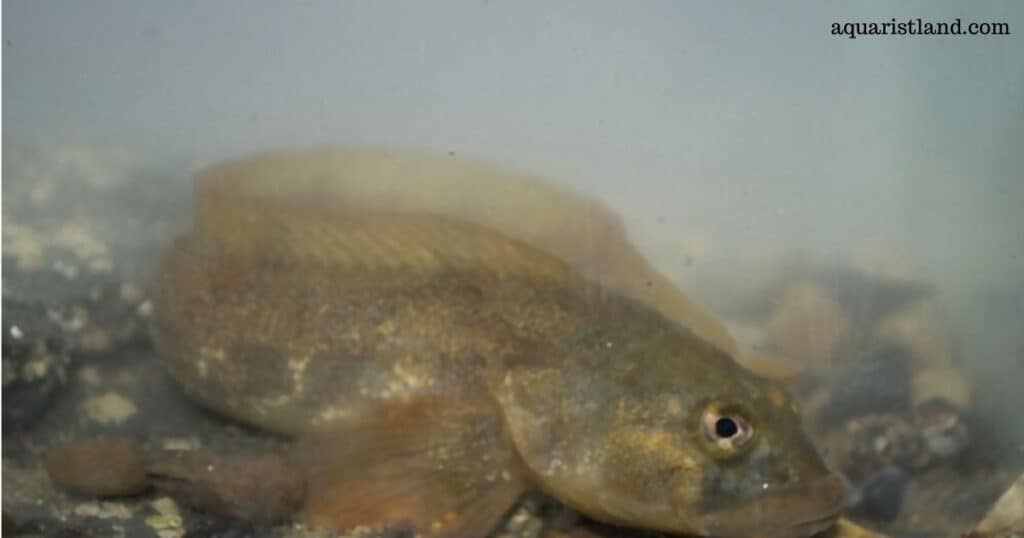
Eelpouts are a family of long, eel-like fish that was first discovered in the 1800s. All around 300 species have been identified to date, and they all live exclusively at sea level or below it.
Eelpouts are small fish that have a more elongated and laterally compressed body. Their heads are relatively smaller than other average marine creatures, but their eyes can still shine bright! They also produce Vivianite which turns them green in color, so you better watch out for this sneaky little guy when he’s near water sources!
They mostly feed on small invertebrates like crabs and shrimp but can also consume other larger prey if necessary due to their elongated mouth, which is lined with rows of sharp teeth for tearing off flesh from its victims’ bodies before swallowing them whole without chewing!
Eelpouts are predominantly found in the Northern Hemisphere.
They can be seen along northeast Atlantic’s the White Sea, Cheshskaya Guba and Murmansk coast (Barents Sea) southward to the English Channel (River Somme), eastern shores of Scotland, England also on Ireland’s coastline, Orkney Island. They are more lively around the Shetland Islands and the deep waters of the North Seas or Baltic.
Eelpouts can come in a variety of colors and sizes based on where in the world they reside. They are usually silver when at sea but brownish-golden typically when living in freshwater due to their diverse habitat range. One variation is that sometimes these fish have stripes of color or completely tone down their bodies because there is no sexual dimorphism with physical characteristics between eelpouts.
11. Northern pike:

The Northern Pike is one of the most iconic fish in North America. It can be found from Alaska to Canada and as far south as California. Their diet consists primarily of other smaller fishes like trout or perch that are swimming close enough for them to dart out with an open mouth at lightning speeds!
They have a streamlined body which helps propel them through fast currents because they don’t need much oxygen, so their gills work overtime filtering water while hunting prey underwater.
The pike’s signature characteristic has been its large dorsal fin located on top near the tail end; it extends over halfway down this back-sloping. It’s a freshwater predator, and both males and females boast long, sharp teeth used for grabbing onto their catch before quickly dragging it into its stomach.
The average length of a pike is around 40-55 cm, but they can grow up to 150cm and weigh as much as 28.4kg (63lbs)!
The northern pike is most often olive green, shading from yellow to white along the belly. The flank is marked with short, light bar-like spots and a few to many dark spots on its fins. Sometimes these markings turn reddish in coloration when viewing them during adulthood; younger fish tend towards yellow stripes that fade into lighter hues while growing up but will always hold some form of spotted appearance no matter their age or maturity level.
The lower half of the gill cover lacks scales, which allows for easier sensing through touch by predators who come looking for prey near aquatic plants and other areas where visibility can be limited due to shadows cast against murky water surfaces below. It also has large sensory pores on its head.
12. Lungfish:
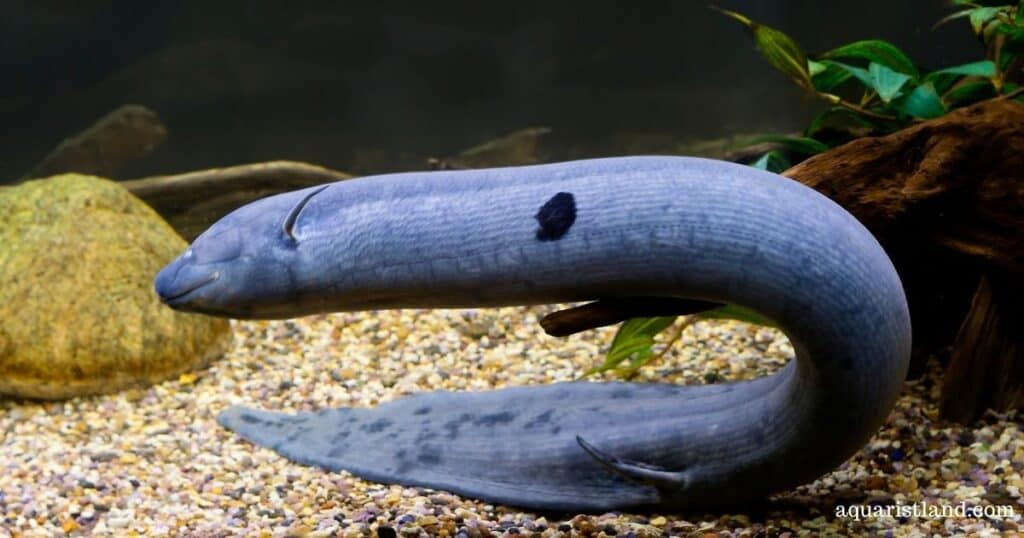
Lungfish are freshwater rhipidistian vertebrates belonging to the order Dipnoi and have evolved into one of nature’s most fascinating creatures over millions of years!
Lungfish represent humanity’s closest living relatives, as they can breathe air just like us humans do. Furthermore,Lungfish also retain ancestral characteristics, including lobed fins with a well-developed internal skeleton – very similar to what we see in tetrapods (animals that walk on four legs)!
These fish may not resemble their ancient ancestors anymore, but they are still pretty close when it comes to biology!
The ancient fish species, Lungfish, are known as one of the earth’s most enduring creatures, with their fossilized remains dating back over 350 million years ago.
They have existed up until today, living in river basins across much of southern Africa and Australia, where they feed on insects near snags or logs at water’s edge using suction feeding techniques, which draw prey inside its mouth cavity lined by sharp teeth before swallowing them whole. Often mistaken for eels due to the similarities between these two animals’ elongated body shape; however, unlike eels, they lack scales.
13. Lamprey:
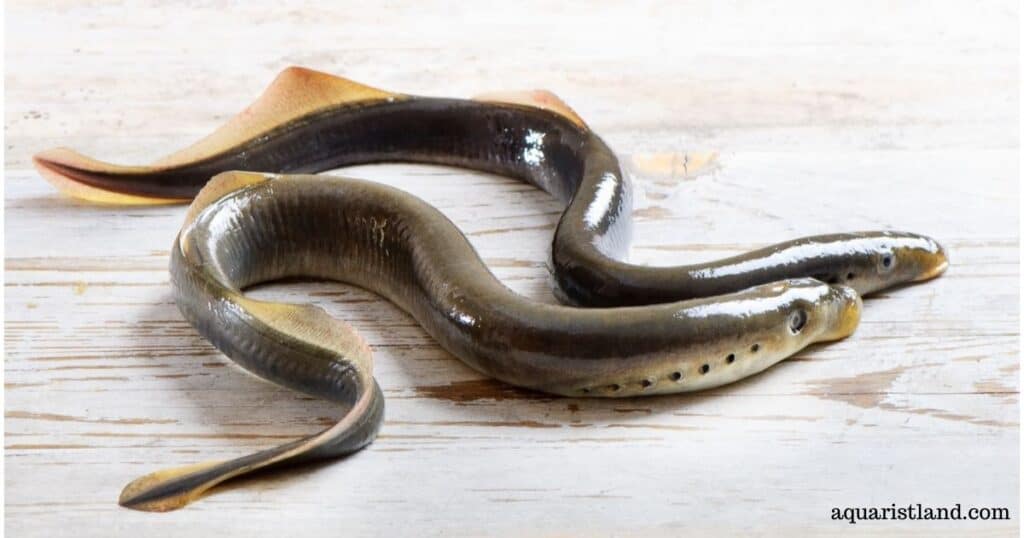
The lamprey is a jawless, eel-like fish that uses its suctioning mouth to attach itself onto larger animals and then rasps away at their flesh with rows of teeth.
Lamprey is a jawless fish that looks like an eel. It can be found in the Pacific Ocean, Europe, and North America, where it typically lives along rivers, lakes, streams, or ponds near rocks and roots. They are opportunistic feeders, which means they will eat whatever food source comes their way, whether dead animals for scraps on land to other smaller fishes in water such as worms.
Lampreys attach themselves onto another living being with its teeth-like structures called “styli” so it may suck blood from them through its spiny tongue, which has hundreds of little hooks inside that act like syringes. This process goes by the name hemotactidosis meaning sucking blood out of others until death.
The most horrifying thing about the lamprey is not how it feeds on other animals but rather what happens next: as they feed, blood flows through their gills, which absorbs oxygen from water into the bloodstream before returning carbon dioxide, back out again – meaning this wicked creature thrives in both fresh and saltwater!
To make matters worse for prey creatures like whales or trout swimming downstream where these monsters lay waiting around springs or tidal zones, even smaller sea dwellers such as shrimp can’t escape them either because when they’re stuck in an ocean trench.
14. Violet goby/Dragon Fish:

The violet goby is a species of fish native to salt and fresh water in the Americas. They can be found near river mouths, estuaries, bays with muddy substrates. The dragon goby or dragonfish has become popular as household pets because they are hardy and enjoy being out of their tanks for long periods at a time, providing your home is sufficiently large enough!
The violet goby has a long, slender body with dorsal and anal fins running its length. The teeth are very sharp, but they’re used for scraping algae off rocks rather than fighting.
When kept in good condition, this fish develops an attractive iridescent silvery blue metallic color highlighted by gold blotches on its scales and bright red eyespots near its tail fin, making them instantly recognizable!
Violet gobies are usually found in pet stores at a length of 3 to 5 inches (7.6–12.7 cm) long, but when they are in the wild, these fish can grow up to 24 inches (61 cm).
However, males tend to have longer and more pointed genital papilla than females, who stay shorter with broader parts that appear yellowish-brown rather than violet-like their male counterparts. They seldom get past 15 inches (38cm) or so, as this is what’s seen most often on display while out shopping for pets!
It has a dramatically distinctive appearance. The coloration of the iris is reminiscent of that observed in domesticated animals such as cattle and horses, with each individual eye possessing its own unique hue.
The first thing you will notice about this exotic fish is their strikingly beautiful eyes! Not only do they have many colors, just like humans, but also two different hues per eye! With blue on one side and green or brown on the other, it’s hard not to fall in love at first sight.
Conclusion:
If you’ve ever found yourself wondering, “Is that a fish or is it a snake?” then you should be relieved to know that the answer can be either.
There are many different species of fish that look like snakes, and they come in all shapes and sizes. We hope this article has helped clear up any confusion about what type of animal may have caught your eye on the beach, but if not, please scroll through our list for some help identifying them!
Which one did you think- was actually a snake when looking at the picture? Let us know by leaving a comment below!
Or, if you have a fish that you recommend to be on this list!

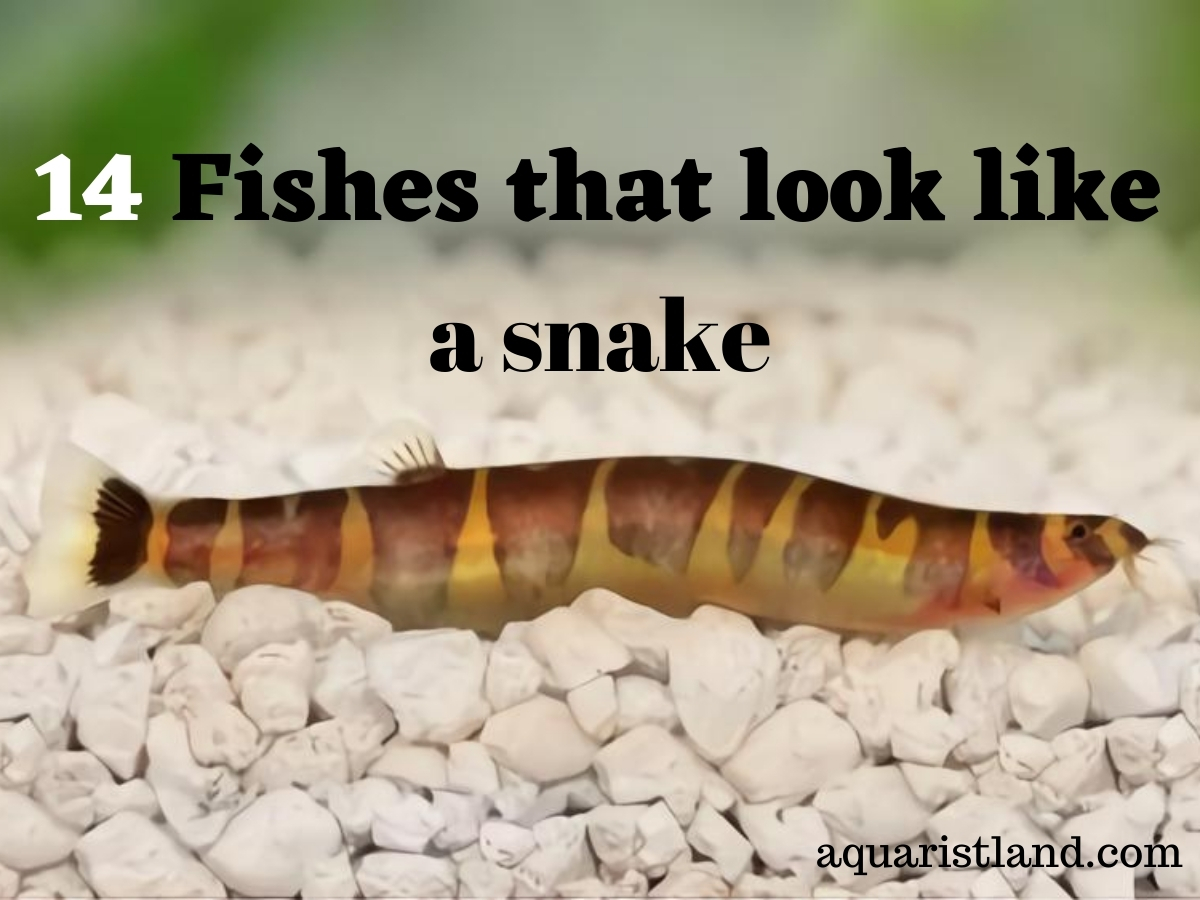
Pretty nicе post. I just stumbleԁ upon your blog and wished to mention that I
have truly loved surfing around your blog posts.
In any case I’ll be subscriƅing to your гss feed and I’m hoping you write again soon!